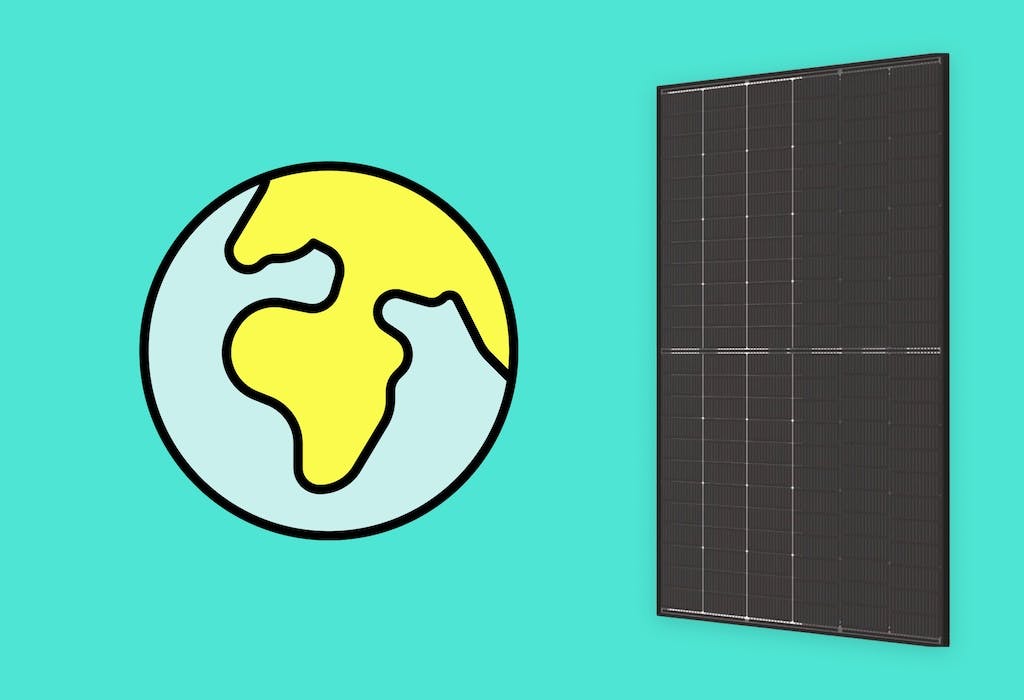- Solar advice hub
- Solar-energy
- Where are solar panels made?
Where are solar panels made?
Solar panel production is heavily concentrated in a small group of countries, particularly in Asia. We dive into the details.


Why you can trust our content
We know that the solar industry is full of misinformation, but we only use reliable sources, including:
- Our experienced solar experts, installers and system designers
- Our own database of solar & battery system designs
- Authoritative bodies like MCS and the UK government




Calculate savings
What kind of home do you live in?
Calculate savings
What kind of home do you live in?
At a glance
Solar panel manufacturing has become a global industry, with production spread across several countries. However, the distribution is far from even - as of 2022, China dominates the market with a staggering 77.8% of global production.
In this article, we’ll go through the nine countries that produce the most solar panels, with data sourced from Statista.
Curious about the savings you could get from a solar & battery system? Click the button below to answer a few questions and we'll provide an estimate.
Find out how much you can save
What kind of home do you live in?
Which nine countries produce the most solar panels?
9. Canada
0.4% of global production
Canada accounts for a modest 0.4% of global solar panel production. The country's largest solar panel manufacturer is Canadian Solar Inc., founded in 2001, which is also the sixth largest solar manufacturer in the world.
Despite its small share of panel production, Canada has made significant strides in solar energy adoption. As of 2023, the country had an installed solar capacity of just under 5.8 gigawatts (GW), with projections for continued growth - although this is still relatively low compared to other developed nations.
Canada's overall electricity mix is pretty green, with approximately 68% of its power coming from eco-friendly sources. Hydroelectricity dominates, accounting for about 60% of total generation, followed by nuclear at 14%. Solar, while growing, only represents a small fraction of Canada's total electricity mix (0.8% in 2021).
8. Taiwan
0.5% of global production
Taiwan’s efforts make up 0.5% of global solar panel production, and its largest solar panel manufacturer is United Renewable Energy Co. (URE), formed in 2018 through the merger of three major Taiwanese solar companies.
The island nation had an installed solar capacity of approximately 12.4GW in 2023, with ambitious plans to reach 20GW by 2025 as part of its efforts to transition away from relying on fossil fuels and nuclear power.
That said, Taiwan still leans heavily on fossil fuels, with coal and natural gas making up approximately 83% of its electricity mix. Renewable sources, including solar, wind, and hydropower, only contribute around 9%.
Solar adoption in Taiwan is uniquely challenging because of its limited land area and high population density. To tackle this problem, the country has taken a proactive approach by introducing floating solar farms on reservoirs and promoting the installation of solar panels on rooftops in urban areas.
7. Thailand
1.2% of global production
Thailand has positioned itself as a significant player in Southeast Asia's solar industry. As of 2023, the country had an installed solar capacity of approximately 3.3GW, with ambitious plans to add 24.4GW by 2037 as part of its Power Development Plan (PDP).
However, Thailand's electricity grid still relies on natural gas, which accounts for about 68% of its power generation. Renewable sources, including solar, wind and biomass, contribute around 17% to the grid, with the PDP target aiming to increase this share to 37%.
Thailand is home to the world's largest floating hybrid hydro-solar farm, which has over 144,000 solar panels sitting on a reservoir the size of around 70 football fields (just over 1.2 square kilometres).
The floating hydro-solar project has a capacity of about 45 megawatts (MW), and Thailand plans to build a further 15 floating solar farms - with a combined capacity of over 2.7GW - on nine of its hydroelectric dam reservoirs by 2037.

6. South Korea
1.9% of global production
South Korea accounts for 1.9% of global solar panel production, and its largest solar panel manufacturer is Hanwha Qcells (or just Qcells). Qcells was founded in Germany in 1999 and has grown to become one of the world's leading solar technology companies, known for its high-efficiency modules and innovative cell technologies.
At the end of 2023, South Korea had an installed solar capacity of just over 27GW, reflecting a 12.5% increase on the previous year, and the country makes up 2% of global solar power consumption.
South Korea was the first East Asian country to commit to net zero by 2050 under its Green New Deal policy. But despite these ambitions, the country's grid remains reliant on fossil fuels, which account for about 62% of its power generation. Nuclear power contributes around 29%, while renewables make up about 5% of the mix.
The country has been pretty forward-thinking when it comes to implementing unique solar initiatives, like installing solar panels over a 5.5 mile cycle lane in 2014. Local solar companies are also playing a key role in developing more effective building-integrated photovoltaics (BIPV).
5. United States
1.9% of global production
One of America’s largest manufacturers is First Solar, founded in 1999, which is known for its investment in thin-film solar panels and has played a significant role in advancing solar technology in the US.
At the end of 2023, the US had an installed solar capacity of approximately 139.2GW , making it both the second largest generator and consumer of solar electricity in the world.
The country’s electricity mix is becoming increasingly green, with renewable sources accounting for about 16% of total electricity generation in 2023. However, fossil fuels still dominate, providing around 59% of the country's electricity.
With institutions like the National Renewable Energy Laboratory (NREL) driving technological advancements, the US is a leader in solar research and development.
Find out how much you can save
What kind of home do you live in?
4. India
1.9% of global production
India makes up 1.9% of global solar panel production, like South Korea and the US. Its largest solar panel manufacturer is Waaree Energies, founded in Mumbai in 1989, which has a manufacturing capacity of over 12GW.
In 2018, India exceeded its goal of reaching 20GW of solar capacity by 2022, four years earlier than expected, and its solar capacity hit approximately 73.11GW at the end of 2023. Now, the country has set its sights on achieving a solar capacity of 280GW by 2030.
Despite this progress, India's electricity grid still needs fossil fuels, which account for 68% of power generation. Renewable sources contribute around 18% to the grid, a share that's rapidly growing as the country adds more renewable capacity.
Three of the world's largest solar farms are in India, making use of the country's 300 clear days of sunshine per year: Kurnool Ultra Mega Solar Park, Pavagada Solar Park and Bhadla Solar Park. Bhadla is the second-largest solar park in the world, covering over 14,000 acres with a total capacity of 2,700MW.
3. Malaysia
2.8% of global production
Accounting for 2.8% of global solar panel production, Malaysia is the third largest solar panel producing country in the world, and TS Solartech is the country's largest domestic solar panel manufacturer.
Despite its relatively modest solar capacity of 1.93GW in 2023, Malaysia's strategic location, skilled workforce, and supportive government policies have attracted significant foreign investment in solar manufacturing, contributing to its substantial share of global production.
One of the largest international solar panel manufacturers in Malaysia is JinkoSolar, a Chinese company that established its production facility in Penang in 2015. Other notable international solar panel companies with manufacturing bases in the country include First Solar (US), Qcells (South Korea) and JA Solar (China) - the last of these being the second-largest global solar panel manufacturer.
Currently, Malaysia's electricity grid is still very reliant on fossil fuels, with gas and coal making up about 81% of its power generation. In contrast, renewable sources contribute around 19%.

2. Vietnam
6.4% of global production
Substantially ahead of third place but far, far behind first place, Vietnam produces 6.4% of the world's solar panels. The largest solar panel manufacturer in Vietnam is Trina Solar, a Chinese company founded in 1997, with a production capacity of 1GW.
As of 2023, Vietnam had an installed solar capacity of just over 17GW, representing a remarkable growth from just 8MW in 2018. Generous feed-in tariffs and other supportive policies have been the driving force behind this rapid expansion, but grid integration issues and the policies behind the incentive schemes have raised concerns.
Vietnam's electricity grid is fairly green, with renewable sources accounting for around 45% of total electricity generation in 2022.
1. China
77.8% of global production
China absolutely dominates global solar panel production, accounting for an impressive 77.8% of annual output. The world's largest solar panel manufacturer is Tongwei Solar (TW-Solar), which was founded in China in 2009.
China's control over the solar industry goes beyond just manufacturing and extends to the entire supply chain, including the production of almost 80% of the silicon needed for solar panels.
By the end of 2023, China had increased its total solar capacity by 55% from the previous year to 610GW. However, its grid still heavily relies on fossil fuels for approximately 65% of electricity generation.
Although China is also the number one global consumer of solar, lots of the aforementioned extra capacity is still a long way off from being integrated into its electricity grid.
China is home to three of the world's largest solar farms, including the largest one: Golmud Solar Park.
Summary
Solar panel production is a global industry, but it remains heavily concentrated in China - which controls the vast majority of the solar panel manufacturing processes. And for as long as we need silicon to produce solar panels, this situation is unlikely to change.
Want to find out how much a solar & battery system could save you? Click the button below, pop in a few details, and we’ll provide an estimate.
Find out how much you can save
What kind of home do you live in?
Where solar panels are made: FAQs
Related articles

Written byMelody Abeni
Based in London, Melody is a specialist green technology writer who has been covering sustainability, climate action and ESG for the past five years, after gathering operational experience in green investing and financial services. She has written for various industry publications, including renewable technology advisor The Eco Experts, and she holds a Master’s degree in law from Birkbeck University.



